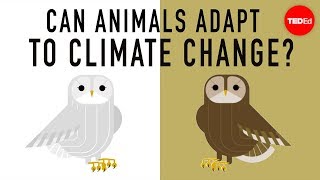(单词翻译:单击)
Rising temperatures and seas, massive droughts, changing landscapes.
日渐升高的温度和海平面,严重的干旱,变化的地形。
Successfully adapting to climate change is growing increasingly important.
这一切都让使成功适应气候变化的能力变得更为重要。
For humans, this means using our technological advancement to find solutions, like smarter cities and better water management.
对于我们人类来说,是使用先进的科技,去找寻解决的方案,例如更加智能的城市和更加完善的水资源管理。
But for some plants and animals, adapting to these global changes involves the most ancient solution of all: evolution.
但是对于动物和植物来说,要想适应这些变化,需要最为古老的方式,那就是进化。
Evolutionary adaptation usually occurs along time scales of thousands to hundreds of thousands of years.
进化通常需要几亿甚至是几十亿年的时间。
But in cases where species are under especially strong selective conditions, like those caused by rapidly changing climates,
但是在例如急速的气候变化之类的极其严苛的淘汰环境下,
adaptive evolution can happen more quickly.
物种正在进行着迅速的进化。
In recent decades, we've seen many plants, animals, and insects relocating themselves
在最近的几十年里,我们见证了很多植物、动物、昆虫的迁移,
and undergoing changes to their body sizes, and the dates they flower or breed.
他们经历了体型大小的变化,以及开花、繁殖时间的变化。
But many of these are plastic, or nonheritable changes to an individual's physical traits.
但是对于个体的生理特征来说,许多变化都是可塑的,即不能够遗传的变化。
And there are limits to how much an organism can change its own physiology to meet environmental requirements.
而且一个生物体为了适应环境要求所能改变自己生理机能的能力是有限的。
That's why scientists are seeking examples of evolutionary changes coded in species' DNA
这就是为什么科学家们正在从物种的DNA中找寻进化的例子,
that are heritable, long-lasting, and may provide a key to their future.
这些进化出来的变化是可遗传的,是持久的,并且对物种的未来意味着很多。
Take the tawny owl. If you were walking through a wintry forest in northern Europe 30 years ago,
以灰林鸮为例。如果30年前,你行走在北欧寒风刺骨的森林里,
chances are you'd have heard, rather than seen, this elusive bird.
你可能看不到这种难觅踪迹的鸟,而只可能听到它们的声音。
Against the snowy backdrop, its plumage would have been near impossible to spot.
在白雪的背景下,它们的羽毛难以被发现。
Today, the landscape is vastly different.
今天,情况大为不同。
Since the 1980s, climate change has led to significantly less snowfall,
自从上世纪80年代气候变化导致降雪量急剧减少,
but you'd still struggle to spot a tawny owl because nowadays, they're brown.
但你还是很难找到灰林鸮,因为现在它们变成棕色了。
The brown color variant is the genetically dominant form of plumage in this species,
这种棕色变异是这种物种的显性性状,
but historically, the recessive pale gray variant triumphed because of its selective advantage in helping these predators blend in.
但历史上是浅灰色隐性性状占了上风,因为这些有选择性的特殊的优势,这些捕食者得以融入环境。
However, less snow cover reduces opportunities for camouflage,
但是,降雪量减少让它们的伪装效果下降,
so lately, this gray color variant has been losing the battle against natural selection.
所以在最近的自然选择里,灰色变异只占了下风。

The offspring of the brown color morphs, on the other hand,
然而,那些有着棕色变异的后代,
have an advantage in exposed forests, so brown tawny owls are flourishing today.
在暴露的森林里具有优势,棕色的灰林鸮越来越多。
Several other species have undergone similar climate-change-adaptive genetic changes in recent decades.
其他的一些物种在最近几十年也经历了类似的适应气候变化的变异。
Pitcher plant mosquitoes have rapidly evolved to take advantage of the warmer temperatures,
猪笼草蚊快速地进化,以利用更加温暖的天气
entering dormancy later and later in the year.
它们越来越晚的进入冬眠。
Two spot ladybug populations, once comprised of equal numbers of melanic and non-melanic morphs,
之前有同等数量黑色和非黑色变异的二星瓢虫,
have now shifted almost entirely to the non-melanic color combination.
现在完全变成了非黑色。
Scientists think that keeps them from overheating.
科学家认为这有利于使它们身体温度不会过高。
Meanwhile, pink salmon have adapted to warmer waters by spawning earlier in the season to protect their sensitive eggs.
与此同时,那些通过更早产卵来保护脆弱的卵的细磷大马哈鱼,适应了更加温暖的水域。
And wild thyme plants in Europe are producing more repellent oils
欧洲的野百里香分泌了更多的防护油,
to protect themselves against the herbivores that become more common when it's warm.
来保护自己免受因为温暖天气产生的越来越多的食草动物的侵扰。
These plants and animals belong to a group of about 20 identified species with evolutionary adaptations to rapid climate change,
这些物种属于一个有20种明确物种的种群,有着包括蛇鳄龟在内的为了适应气候变化而产生进化的物种。
including snapping turtles, wood frogs, knotweed, and silver spotted skipper butterflies.
如林蛙,紫菀科植物,以及银斑弄蝶。
However, scientists hope to discover more species evolving in response to climate change out of 8.7 million species on the planet.
然而,科学家们希望在地球上的八千七百万物种中发现更多帮助适应气候变化的物种进化。
For most of our planet's astounding and precious biodiversity, evolution won't be the answer.
因为对于我们星球珍贵惊人的生物多样性来说,进化不是最终的答案。
Instead, many of those species will have to rely on us to help them survive a changing world or face extinction.
反之,很多物种需要依靠我们去帮助它们在一个变化的世界生存下来,否则,它们将会灭亡。
The good news is we already have the tools.
好消息是我们已经有了一些工具。
Across the planet, we're making on-the-ground decisions that will help entire ecosystems adapt.
全球范围内,我们已经做出了一些实实在在的决定,那些决定将会帮助整个生态系统去适应。
Critical climate refuges are being identified and set aside,
那些受气候变化影响极大的气候“难民”正在被鉴定和保护,
and projects are underway to help mobile species move to more suitable climates.
那些帮助迁徙物种的计划正在进行,它们可以迁徙到更加合适的气候环境中去。
Existing parks and protected areas are also doing climate change check-ups to help their wildlife cope.
现有的公园和保护区正在开展气候变化调查来帮助野生动物适应。
Fortunately, it's still within our power to preserve much of the wondrous biodiversity of this planet,
幸运的是,这一切还在我们的控制之内,我们还能够保护这个星球上奇异的生物多样性,
which, after all, sustains us in so many ways.
毕竟它们正在通过各种方式支持着我们人类的生存。


